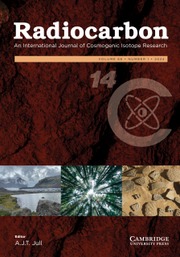Article contents
Bomb Carbon as a Tracer of Dietary Carbon Sources in Omnivorous Mammals
Published online by Cambridge University Press: 18 July 2016
Abstract
We have isolated amino acid groups from modern bone hydrolysates and compared their relative Δ14C value to assess the carbon contribution of diet to the overall radiocarbon signal in bone. We find that both essential and non-essential amino acids may produce widely varying 14C, relative to other amino acid groups in the hydrolysate and to the original whole bone protein. We hypothesize that the 14C variations in non-essential amino acids may be due to metabolic effects that utilize essential amino acid carbon skeletons in the creation of non-essential amino acids.
- Type
- I. Our ‘Dry’ Environment: Above Sea Level
- Information
- Copyright
- Copyright © 2001 by the Arizona Board of Regents on behalf of the University of Arizona
References
- 6
- Cited by


